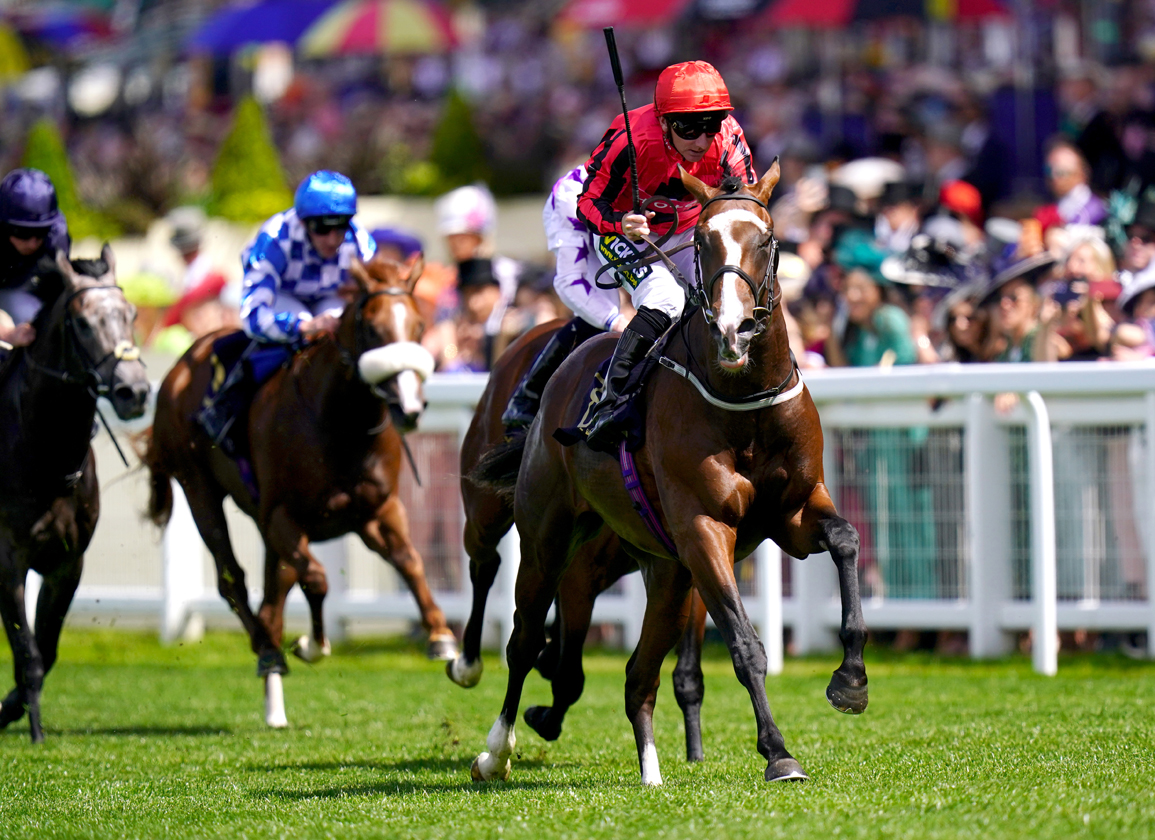By Dan Ross
Last week at Royal Ascot, The Ridler (Brazen Beau) sprang a surprise in the G2 Norfolk S. when out-performing his odds of 50-1. That wasn't the only odd spell The Ridler cast during the race.
Into the final furlong, The Ridler drifted markedly left across the field, hampering the chances of several other runners. Controversially for some, The Ridler kept the race after a steward's inquiry.
During a presentation at Wednesday's Grayson-Jockey Club Research Foundation Welfare and Safety of the Racehorse Summit, Will Duff Gordon, CEO of Total Performance Data, which provides in-running horseracing data, provided another intriguing way to examine the race.
Duff Gordon presented a chart showing the acceleration and speed of a horse during the race, and how it was impeded by the winner.
“You can see how that horse in blue, how much its velocity was cut off,” said Duff Gordon, pointing to the marked deceleration of a beaten runner at the time of The Ridler's antics.
“That's a much better way of telling the story rather than running the replay 700 times, which is what the TV companies have done to date,” said Duff Gordon. “The stewards can't yet use that information,” he added, “but hopefully they will soon.”
Duff Gordon was part of a panel looking at some of the data collection technologies forging a new path in equine welfare and performance during racing and training, and racecourse customer experience.
“This is a new frontier,” said Scott Palmer, equine medical director for the New York Gaming Commission, about the StrideSAFE sensor, which TDN has written about here.
Nevertheless, the panelists emphasized how, in many regards, the stamp from data collection on the racing world is still very much a fresh one.
Greater accuracy comes from sheer depth in numbers, and pick-up of these technologies among industry stakeholders at large has been finicky at best.
Correct interpretation of the data is also key. Racing is hardly awash with number crunchers, data analysts and epidemiologists. That's why, said Palmer, “this is baby steps right now.”
Duff Gordon agreed.
“We create in-running odds. That's making 10,000 calculations per-horse, per-second to predict who's going to win the race. We can refine that all the time,” he said.
“The last few years has been about acquiring the data, getting onto as many racecourses as possible. The present and the future's all about producing front ends and mining that data, so we're hiring huge numbers of data scientists,” Duff Gordon added. “Any budding data scientists, please do get in touch with me. We can never get enough of them.”
Presided over by New York Thoroughbred Horseman's Association president, Joe Appelbaum, the panel also included Valentin Rapin, managing director and co-founder of Arioneo, a horse performance company.
The technologies that Arioneo produces are geared around morning training, including heart-rate monitoring, locomotion and stride data, and GPS tracking of speed, distance and acceleration.
Broadly speaking, these discreet, easy-to-use technologies can be utilized to gauge things like the overall fitness level of the horse, it's optimum speed, suitable distances and ground preferences.
There's a welfare element, too, explained Rapin, as the heart-rate monitor gives trainers the ability to check for cardiac abnormalities.
“Let's say the horse is about 125 beats a minute every day. If one day you see the heart rate go up to 140, 150, it will probably mean there is something wrong,” said Rapin.
“You can contact your vet directly or your vet can also have access to the data via distance to monitor this for you,” Rapin added.
“It's really in the strike-rate,” interjected Duff Gordon.
“The trainers who have that huge, extra level of insight, their horses are ready to rumble and you have trainers with less horses punching above their weight,” Duff Gordon said, pointing towards the likes of George Boughey, a young UK-based trainer with an English Classic win to his name into just his fourth year with a license.
“He's got less than 50 horses, and [has] no right to be winning [like he is],” said Duff Gordon, adding how the likes of Boughey have harnessed the use of performance monitoring technologies with shrewd purchases at the sales.
StrideSAFE is a technology that fits into a horse's saddle towel with the ability to detect at high speeds lameness invisible to the naked eye. Since last summer, it has been used on thousands of starters across Saratoga, Belmont and Aqueduct.
“What were able to do with this device is actually detect lameness in early stages to provide for timely intervention,” said Palmer.
“We can work with the trainer and say, 'Your horse is not lame today, but the warning signs are clear. You need to get this horse evaluated by a veterinarian. It needs a good diagnostic workout because something's going on here,'” Palmer added.
Hundreds of times a second, this wireless iPhone-shaped device takes an assortment of measurements to capture in minute detail the movement of the horse at high speed.
These measurements include the horse's acceleration and deceleration, the up and down concussive movement of the horse, and its medial-lateral motion–what is, in other words, the horse's movement from side to side.
It works like a traffic light signal, providing a green for all-clear, an amber for possible caution, and a red for possible danger. These ratings are calculated by how many standard deviations the horse is from the norm.
“If they exceed three standard deviations from the mean we have what we call red alert, and that means there's something happening in this race that needs to be investigated,” said Palmer. “There's a change here.”
Palmer told the story of early on into the trial of a horse that finished second in a maiden special weight at Saratoga.
Immediately after the race, the horse appeared healthy and sound. But when Palmer received the StrideSAFE read-out of the race the following day, it showed worrying abnormalities in the horse's balance.
“When I got this data, I didn't know exactly what it meant,” said Palmer, who said that he called the trainer, asked about the horse.
“The trainer said, 'Well, this horse finished the race great.' Jockey had hopped off. Trainer was there in the unsaddling area. Everybody was happy, finished second in a maiden special weight for 2-year-olds at Saratoga,” said Palmer.
By the time the horse had walked back to the test barn and began to cool-out, it became lame–so much so, the horse had to be shipped back to the barn. A subsequent radiograph showed the horse had suffered an acute fracture of the third carpal bone.
“It was a very dramatic example for me that we were measuring something important,” said Palmer.
While researchers are still analyzing the data from the longer study, Palmer shared some numbers showing attrition rates among a small cohort of horses studied at Saratoga: 15 that had received red alerts, 25 with a yellow alert, and 91 with green alerts.
Broadly speaking, the horses with a red alert generally did not make it back to race for a “significant amount of time” as compared to the yellow and green horses, said Palmer.
The red horses didn't compete in as many races as the yellow and green alerted horses during a four-month follow-up period, nor complete as many high-speed workouts, added Palmer.
“Interestingly, only 40% of the horses that had a red classification were able to race at all over the next four months after the analyzed race compared to almost 80% of the greens and the yellows,” said Palmer. “I thought that was powerfully significant.”
In his “zealot's pitch” at the end of the panel discussion, Appelbaum implored the industry to accelerate its adoption of these kinds of technologies.
“There's not a human football player or soccer player at the professional level that's not using a catapult vest. In F1, the drivers all use gloves that track their heart rate and perspiration. Weightlifters are all using push-bands to understand their load,” said Appelbaum.
“Humans sports are about 10 years ahead of us,” Appelbaum added. “But we can catch up and we should catch up. It's not just for the benefit of the betting public, but it's really for the benefit of the horses.”
Not a subscriber? Click here to sign up for the daily PDF or alerts.







